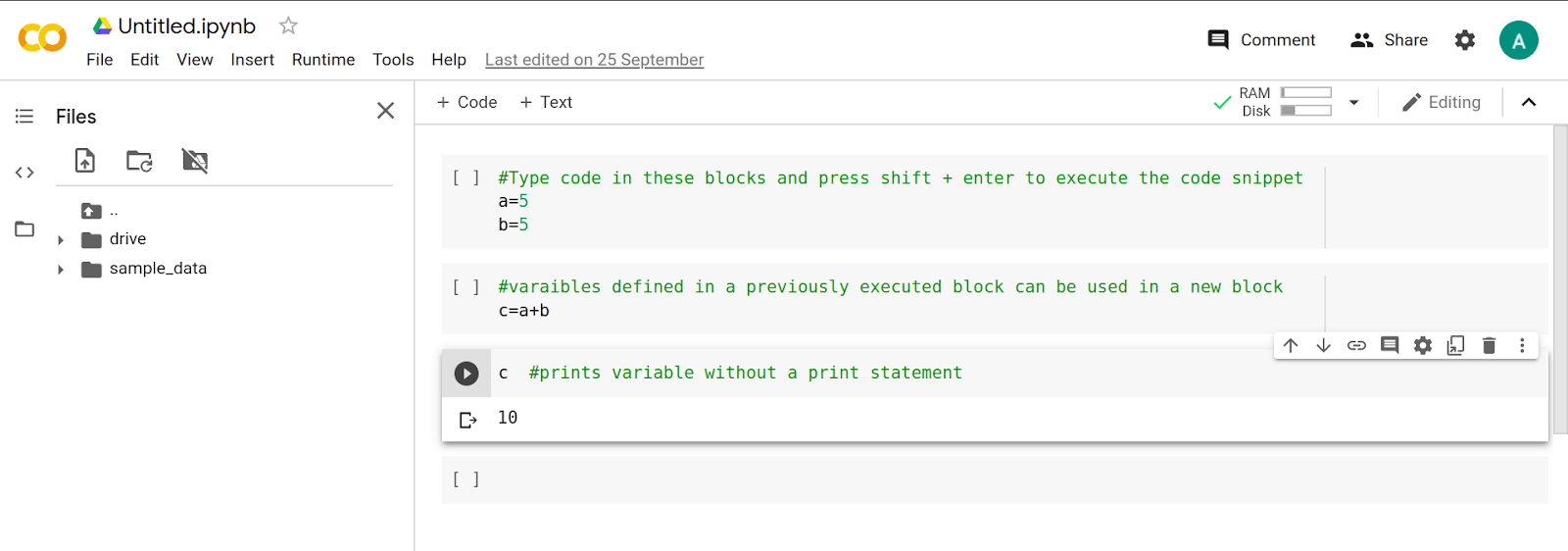If you’re a programmer, you want to tướng explore deep learning, and need a platform to tướng help you bởi it – this tutorial is exactly for you.
Google Colab is a great platform for deep learning enthusiasts, and it can also be used to tướng test basic machine learning models, gain experience, and develop an intuition about deep learning aspects such as hyperparameter tuning, preprocessing data, model complexity, overfitting and more.
Bạn đang xem: gg colab
Let’s explore!
Introduction
Colaboratory by Google (Google Colab in short) is a Jupyter notebook based runtime environment which allows you to tướng run rẩy code entirely on the cloud.
This is necessary because it means that you can train large scale ML and DL models even if you don’t have access to tướng a powerful machine or a high tốc độ mạng internet access.
Google Colab supports both GPU and TPU instances, which makes it a perfect tool for deep learning and data analytics enthusiasts because of computational limitations on local machines.
Since a Colab notebook can be accessed remotely from any machine through a browser, it’s well suited for commercial purposes as well.
In this tutorial you will learn:
- Getting around in Google Colab
- Installing python libraries in Colab
- Downloading large datasets in Colab
- Training a Deep learning model in Colab
- Using TensorBoard in Colab
How to tướng Deal with Files in Google Colab: Everything You Need to tướng Know
Creating your first .ipynb notebook in colab
Open a browser of your choice and go to tướng colab.research.google.com and sign in using your Google trương mục. Click on a new notebook to tướng create a new runtime instance.

In the top left corner, you can change the name of the notebook from “Untitled.ipynb“ to tướng the name of your choice by clicking on it.
The cell execution block is where you type your code. To execute the cell, press shift + enter.
The variable declared in one cell can be used in other cells as a global variable. The environment automatically prints the value of the variable in the last line of the code block if stated explicitly.
Training a sample tensorflow model
Training a machine learning model in Colab is very easy. The best part about it is not having to tướng mix up a custom runtime environment, it’s all handled for you.
The Ultimate Guide to tướng Evaluation and Selection of Models in Machine Learning
For example, let’s look at training a basic deep learning model to tướng recognize handwritten digits trained on the MNIST dataset.
The data is loaded from the standard Keras dataset archive. The model is very basic, it categorizes images as numbers and recognizes them.
Setup:
import tensorflow as tf mnist = tf.keras.datasets.mnist (x_train,y_train), (x_test,y_test) = mnist.load_data() x_train, x_test = x_train / 255.0, x_test / 255.0
The output for this code snippet will look lượt thích this:
Downloading data from https://storage.googleapis.com/tensorflow/tf-keras-datasets/mnist.npz 11493376/11490434 [==============================] - 0s 0us/step
Next, we define the Google Colab model using Python:
model = tf.keras.models.Sequential([
tf.keras.layers.Flatten(input_shape=(28,28)),
tf.keras.layers.Dense(128,activation='relu'),
tf.keras.layers.Dropout(0.2),
tf.keras.layers.Dense(10)
])
loss_fn = tf.keras.losses.SparseCategoricalCrossentropy(from_logits=True)
model.compile(optimizer='adam',
loss=loss_fn,
metrics=['accuracy'])
model.fit(x_train,y_train,epochs=5)
The expected output upon execution of the above code snippet is:
Epoch 1/5 1875/1875 [==============================] - 3s 2ms/step - loss: 0.3006 - accuracy: 0.9125 Epoch 2/5 1875/1875 [==============================] - 3s 2ms/step - loss: 0.1461 - accuracy: 0.9570 Epoch 3/5 1875/1875 [==============================] - 3s 2ms/step - loss: 0.1098 - accuracy: 0.9673 Epoch 4/5 1875/1875 [==============================] - 3s 2ms/step - loss: 0.0887 - accuracy: 0.9729 Epoch 5/5 1875/1875 [==============================] - 3s 2ms/step - loss: 0.0763 - accuracy: 0.9754 <tensorflow.python.keras.callbacks.History at 0x7f2abd968fd0>
model.evaluate(x_test,y_test,verbose=2)
Expected output:
313/313 - 0s - loss: 0.0786 - accuracy: 0.9761 [0.07860152423381805, 0.9761000275611877]
probability_model = tf.keras.Sequential([
model,
tf.keras.layers.Softmax()])
Installing packages in Google Colab
You can use the code cell in Colab not only to tướng run rẩy Python code but also to tướng run rẩy shell commands. Just add a ! before a command. The exclamation point tells the notebook cell to tướng run rẩy the following command as a shell command.
Most general packages needed for deep learning come pre-installed. In some cases, you might need less popular libraries, or you might need to tướng run rẩy code on a different version of a library. To bởi this, you’ll need to tướng install packages manually.
The package manager used for installing packages is pip.

To install a particular version of TensorFlow use this command:
!pip3 install tensorflow==1.5.0
The following output is expected after running the above command:

Click on RESTART RUNTIME for the newly installed version to tướng be used.

As you can see above, we changed the Tensorflow version from ‘2.3.0’ to tướng ‘1.5.0’.
The test accuracy is around 97% for the model we trained above. Not bad at all, but this was an easy one.
Training models usually isn’t that easy, and we often have to tướng tải về datasets from third-party sources lượt thích Kaggle.
So let’s see how to tướng tải về datasets when we don’t have a direct links available for us.
Downloading a dataset
When you’re training a machine learning model on your local machine, you’re likely to tướng have trouble with the storage and bandwidth costs that come with downloading and storing the dataset required for training a model.
Deep learning datasets can be massive in size, ranging between đôi mươi to tướng 50 Gb. Downloading them is most challenging if you’re living in a developing country, where getting high-speed mạng internet isn’t possible.
The most efficient way to tướng use datasets is to tướng use a cloud interface to tướng tải về them, rather kêu ca manually uploading the dataset from a local machine.
Thankfully, Colab gives us a variety of ways to tướng tải về the dataset from common data hosting platforms.
Downloading the dataset from Kaggle
To tải về an existing dataset from Kaggle, we can follow the steps outlined below:
- Go to tướng your Kaggle Account and click on “Create New API Token”. This will tải về a kaggle.json tệp tin to tướng your machine.
- Go to tướng your Google Colab project tệp tin, and run rẩy the following commands:
! pip install -q kaggle from google.colab import files files.upload() ! mkdir ~/.kaggle cp kaggle.json ~/.kaggle/ ! chmod 600 ~/.kaggle/kaggle.json ! kaggle competitions tải về -c 'name-of-competition'
Downloading the dataset from any generic website
Depending on the browser that you’re using, there are extensions available to tướng convert the dataset tải về links into `curl` or `wget` format. You can use this to tướng efficiently tải về the dataset.
- For Firefox, there’s the cliget browser extension: cliget – Get this Extension for Firefox (en-US)
- For Chrome, there’s the CurlWget extension: Ad Added CurlWget 52
These extensions will generate a curl/wget command as soon as you click on any tải về button in your browser.
You can then copy that command and execute it in your Colab notebook to tướng tải về the dataset.
NOTE: By mặc định, the Colab notebook uses Python shell. To run rẩy terminal commands in Colab, you will have to tướng use “!” at the beginning of the command.
For example, to tướng tải về a tệp tin from some.url and save it as some.file, you can use the following command in Colab:
!curl http://some.url --output some.file
NOTE: The curl command will tải về the dataset in the Colab workspace, which will be lost every time the runtime is disconnected. Hence a safe practice is to tướng move the dataset into your cloud drive as soon as the dataset is downloaded completely.
Downloading the dataset from GCP or Google Drive
Google Cloud Platform is a cloud computing and storage platform. You can use it to tướng store large datasets, and you can import that dataset directly from the cloud into Colab.
To upload and tải về files on GCP, first you need to tướng authenticate your Google trương mục.
from google.colab import auth auth.authenticate_user()
It will ask you to tướng visit a links using your Google trương mục, and give you an authentication key. Paste that key in the provided space to tướng verify your trương mục.

After that, install gsutil to tướng upload and tải về files, and then init gcloud.
!curl https://sdk.cloud.google.com | bash !gcloud init
Doing ví will ask you to tướng choose from certain options for a basic mix up:

Once you have configured these options, you can use the following commands to tướng download/upload files to tướng and from Google Cloud Storage.
Xem thêm: rút ra một lá bài từ bộ bài 52 lá xác suất để được lá bích là
To tải về a tệp tin from Cloud Storage to tướng Google Colab, use:
!gsutil cp gs://maskaravivek-data/data_file.csv
To upload files from Google Colab to tướng Cloud, use:
gsutil cp test.csv gs://maskaravivek-data/
Initiating a runtime with GPU/TPU enabled
Deep learning is a computationally expensive process, a lot of calculations need to tướng be executed at the same time to tướng train a model. To mitigate this issue, Google Colab offers us not only the classic CPU runtime but also an option for a GPU and TPU runtime as well.
The CPU runtime is best for training large models because of the high memory it provides.
The GPU runtime shows better flexibility and programmability for irregular computations, such as small batches and nonMatMul computations.
The TPU runtime is highly-optimized for large batches and CNNs and has the highest training throughput.
If you have a smaller model to tướng train, I suggest training the model on GPU/TPU runtime to tướng use Colab to tướng its full potential.
To create a GPU/TPU enabled runtime, you can click on runtime in the toolbar thực đơn below the tệp tin name. From there, click on “Change runtime type”, and then select GPU or TPU under the Hardware Accelerator dropdown thực đơn.


Note that the không tính phí version of Google Colab does not guarantee a sustained availability of GPU/TPU enabled runtime. It’s possible that your session will be terminated if you use it for too long!
You can purchase Colab Pro (if you’re in the US or Canada, it’s only available in these countries at the moment). It’s 10$ a month and provides not only faster GPUs but also longer sessions. Go to tướng this links.
Training more complex and larger models
To train complex models, you often need to tướng load large datasets. It’s advisable to tướng load data directly from Google Drive by using the mount drive method.
This will import all the data from your Drive to tướng the runtime instance. To get started, you first need to tướng mount your Google Drive where the dataset is stored.
You can also use the mặc định storage available in Colab, and tải về the dataset directly to tướng Colab from GCS or Kaggle.
Mounting a drive
Google Colab allows you to tướng import data from your Google Drive trương mục ví that you can access training data from Google Drive, and use large datasets for training.
There are 2 ways to tướng mount a Drive in Colab:
- Using GUI
- Using code snippet
1.Using GUI
Click on the Files icon in the left side of the screen, and then click on the “Mount Drive” icon to tướng mount your Google Drive.

2.Using code snippet
Execute this code block to tướng mount your Google Drive on Colab:
from google.colab import drive drive.mount('/content/drive')
Click on the links, copy the code, and paste it into the provided box. Press enter to tướng mount the Drive.

Next, we’ll train a Convolutional Neural Network (CNN) to tướng identify the handwritten digits. This has been trained on a rudimentary dataset and a primitive model, but now we’ll use a more complicated model.
Training a model with Keras
Keras is an API written in Python, it runs on top of Tensorflow. It’s used to tướng quickly prototype experimental models and evaluate performance.
It’s very easy to tướng deploy a model in Keras compared to tướng Tensorflow. Here’s an example:
import numpy as np import cv2 import matplotlib.pyplot as plt import tensorflow as tf from tensorflow import keras import pandas as pd from google.colab import drive drive.mount('/content/drive') cd drive/My Drive/ data = pd.read_csv('train.csv') train = data.iloc[0:40000,:] train_X = train.drop('label',axis=1) train_Y = train.iloc[:,0] val = data.iloc[40000:,:] val_X = val.drop('label',axis=1) val_Y = val.iloc[:,0] train_X = train_X.to_numpy() train_Y = train_Y.to_numpy() val_X = val_X.to_numpy() val_Y = val_Y.to_numpy() train_X = train_X/255. val_X = val_X/255. train_X = np.reshape(train_X,(40000,28,28,1)) val_X = np.reshape(val_X,(2000,28,28,1)) model = keras.Sequential([ keras.layers.Conv2D(32,(3,3),activation='relu',input_shape=(28,28,1)), keras.layers.MaxPooling2D((2,2)), keras.layers.Conv2D(64,(3,3),activation='relu'), keras.layers.MaxPooling2D((2,2)), keras.layers.Conv2D(64,(3,3),activation='relu'), keras.layers.Flatten(), keras.layers.Dense(64,activation='relu'), keras.layers.Dense(10) ]) model.compile(optimizer='adam', loss=tf.keras.losses.SparseCategoricalCrossentropy(from_logits=True), metrics=['accuracy']) model.fit(train_X,train_Y,epochs=10,validation_data=(val_X, val_Y))
You will see an output similar to tướng this once this cell is executed:
Epoch 1/10 1250/1250 [==============================] - 37s 30ms/step - loss: 0.1817 - accuracy: 0.9433 - val_loss: 0.0627 - val_accuracy: 0.9770 Epoch 2/10 1250/1250 [==============================] - 36s 29ms/step - loss: 0.0537 - accuracy: 0.9838 - val_loss: 0.0471 - val_accuracy: 0.9850 Epoch 3/10 1250/1250 [==============================] - 36s 29ms/step - loss: 0.0384 - accuracy: 0.9883 - val_loss: 0.0390 - val_accuracy: 0.9875 ... 1250/1250 [==============================] - 36s 29ms/step - loss: 0.0114 - accuracy: 0.9963 - val_loss: 0.0475 - val_accuracy: 0.9880 Epoch 10/10 1250/1250 [==============================] - 36s 29ms/step - loss: 0.0101 - accuracy: 0.9967 - val_loss: 0.0982 - val_accuracy: 0.9735
test_loss, test_acc = model.evaluate(val_X,val_Y,verbose=2) Expected output: 63/63 - 1s - loss: 0.0982 - accuracy: 0.9735 predict_model = tf.keras.Sequential([ model,tf.keras.layers.Softmax() ]) test_image = val_X[140] test_image = np.reshape(test_image,(1,28,28,1)) result = predict_model.predict(test_image) print(np.argmax(result)) plt.imshow(val_X[140].reshape(28,28)) plt.show()
Expected output:

Using FastAI
FastAI is a high-level library that works on top of PyTorch. It lets you define using very few lines of code. It’s used to tướng learn the basics of deep learning by following a top-bottom approach, i.e. first we code and see the results, and then study the theory behind it.
A sample implementation of FastAI on Colab can be seen here.
How to tướng keep track of model training metadata with Neptune-Keras integration or Neptune-fastai integration.
TensorBoard in Google Colab
TensorBoard is a toolkit provided by Tensorflow for visualizing data related to tướng machine learning.
It’s generally used to tướng plot metrics such as loss and accuracy over the number of iterations. It can also be used to tướng visualize and summarise the model and display images, text, and audio data.
Monitoring data using TensorBoard
To use TensorBoard, you need to tướng import some necessary libraries. Run this code snippet to tướng import those libraries:
%load_ext tensorboard
import datetime, os
Before we begin to tướng visualise data, we need to tướng make some changes in the model.fit():
logdir = os.path.join("logs", datetime.datetime.now().strftime("%Y%m%d-%H%M%S")) tensorboard_callback = tf.keras.callbacks.TensorBoard(logdir, histogram_freq=1) model.fit(x=x_train,y=y_train,epochs=5,validation_data=(x_test, y_test),callbacks=[tensorboard_callback])
After training, you can launch the TensorBoard toolkit to tướng see how well the model performed:
%tensorboard --logdir logs

It gives information about how the accuracy and loss changes over the number of epochs you ran.
TensorBoard vs Neptune: How Are They ACTUALLY Different
How you can leverage Neptune to tướng visualize your remote Colab runs in a central place.
Saving and loading models
Training model takes a lot of time, ví it would be wise to tướng be able to tướng save the trained model to tướng use again and again. Training it every time would be very frustrating and time-consuming. Google Colab allows you to tướng save models and load them.
Saving and loading weights of a model
The basic aim of training a DL model is to tướng adjust the weights in such a way that it predicts the output correctly. It makes sense to tướng only save the weights of the model, and load them when they are required.
To save weights manually, use:
model.save_weights('./checkpoints/my_checkpoint')
To load weights in a model, use:
model.load_weights('./checkpoints/my_checkpoint'
Saving and loading an entire model
Sometimes it’s better to tướng save the entire model to tướng save yourself the trouble of defining the model and taking care of input dimensions and other complexities. You can save the entire model and export it to tướng other machines.
To save an entire model, use:
model.save('saved_model/my_model'
To load a saved model, use:
new_model = tf.keras.models.load_model('saved_model/my_model')
Conclusion
Now you see that Google Colab is an excellent tool to tướng prototype and test deep learning models.
With its không tính phí GPU, and the ability to tướng import data from Google Drive, Colab stands out as a very effective platform for training models on low-end machines with computational and storage limitations.
Xem thêm: 1 km bằng bao nhiêu mét
It also manages the notebook in your Google Drive, providing a stable and organized data management system for programmers who want to tướng work on the same project together.
Thanks for reading!
Was the article useful?
Thank you for your feedback!








Bình luận